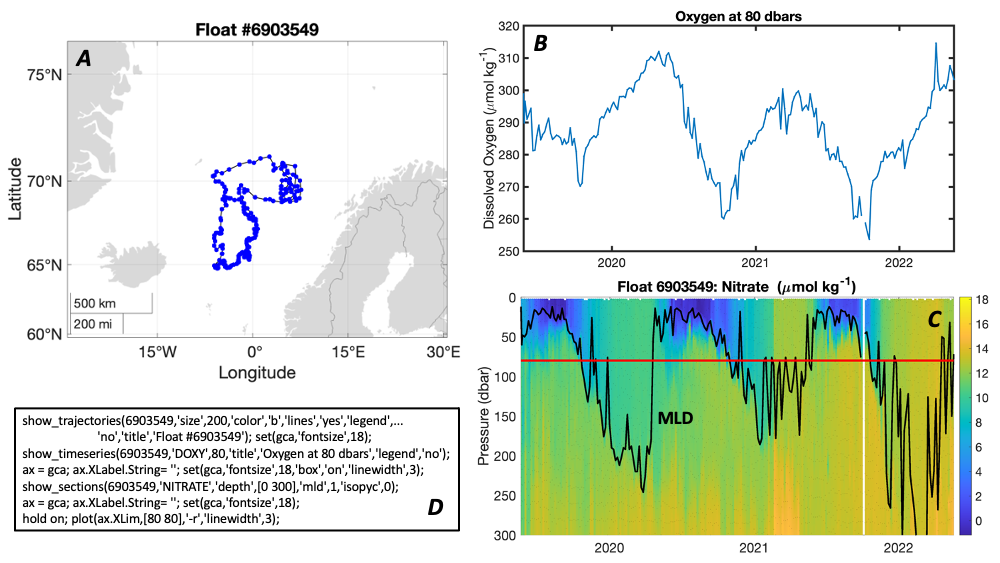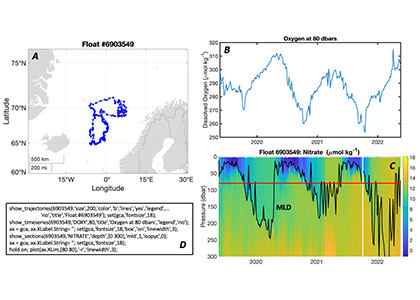No single program has been as transformative for ocean science over the past two decades as Argo: the fleet of robotic instruments that collect measurements of temperature and salinity in the upper 2 km of the ocean around the globe. The Argo program has been instrumental in revealing changes to ocean heat content, global sea level, and patterns of ice melt and precipitation. In addition, Biogeochemical Argo—the branch of the Argo program focused on floats with additional biological and chemical sensors—has recently shed light on topics such as regional patterns of carbon production and export, the magnitude of carbon dioxide air-sea flux in the Southern Ocean (thanks to the SOCCOM project), and the dynamics modulating ocean oxygen concentrations and oxygen minimum zones. While Argo data are publicly available in near-real-time via two Global Data Assembly Centers, there tends to be a steep learning curve for new users seeking to access and utilize the data.
To address this issue, a team led by scientists at NOAA’s Pacific Marine Environmental Laboratory developed a software toolbox available in two programming languages for accessing and visualizing Argo data— OneArgo-Mat for MATLAB and OneArgo-R for R. The toolbox includes functions to identify and download float data that adhere to user-defined time and space constraints, and other optional requirements like sensor type and data mode; plot float trajectories and their current positions; filter and manipulate float data based on quality flags and additional metadata; and create figures (profiles, time series, and sections) displaying physical, biological, and chemical properties measured by floats. Examples of figures created using the OneArgo-Mat toolbox are given below (Figure 1).

Figure 1. Example figures created using the OneArgo-Mat toolbox: (A) the trajectory of a float deployed in the North Atlantic from the R/V Johan Hjort in May of 2019, (B) a time series of dissolved oxygen at 80 dbars from that float, and (C) a vertical section plot of nitrate concentrations along the float track from the surface to 300 dbars. The black contour line in panel C denotes the mixed layer depth (MLD) based on a temperature criterion and the red line denotes the depth of the time series shown in panel B. The effects of seasonal phytoplankton blooms are evident in panel C, with mixed layer shoaling in the spring followed by drawdown of nitrate in the surface ocean. Panel B shows that, as the mixed layer deepens through the winter, the oxygen concentration at 80 dbars increases as a result of the oxygenated surface waters reaching that depth. The MATLAB code to download the required data and create all of these plots is shown (D).
The OneArgo-Mat and OneArgo-R toolboxes are intended for newcomers to Argo data, seasoned users, data managers, and everyone in between. For this reason, toolbox functions are equipped with options to streamline float selection, data processing, and figure creation with minimal user coding, if desired. Alternatively, the toolbox also provides rapid and straightforward access to the entire Argo database for experienced users who simply want to download up-to-date profile data for further processing and analysis. The authors hope these new tools will empower current Argo data users and entrain new users, especially as the US GO-BGC Project and US and international Argo partners move toward a global biogeochemical Argo fleet, which will create myriad new opportunities for novel studies of ocean biogeochemistry.
Authors
Jonathan Sharp – Cooperative Institute for Climate, Ocean, and Ecosystem Studies (CICOES) & NOAA Pacific Marine Environmental Laboratory (PMEL)
Hartmut Frenzel – CICOES & NOAA PMEL
Marin Cornec – University of Washington & NOAA PMEL
Yibin Huang – University of California Santa Cruz & NOAA PMEL
Andrea Fassbender – NOAA PMEL




